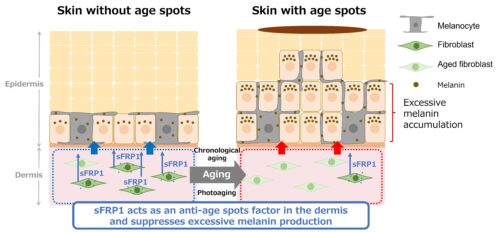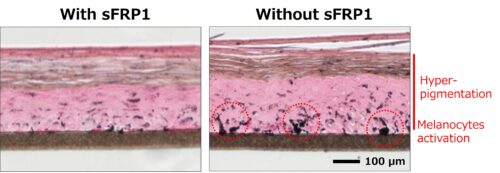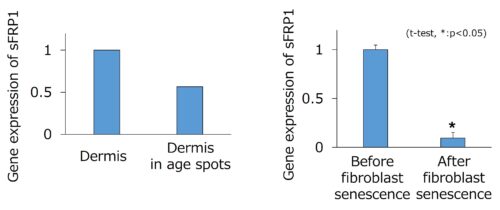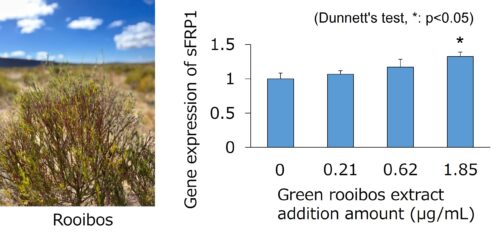R&D Discovery of a Dermal Anti-Age Spot Factor – Elucidating a New Mechanism of Hyperpigmentation Induced by Dermal Cellular Senescence – 2025.11.18 Show Full [ PDF / 432KB ]
KOSÉ Corporation (Tokyo, Japan) has uncovered a new mechanism of hyperpigmentation through joint research with Professor Zalfa A. Abdel-Malek, PhD, of the Department of Dermatology, University of Cincinnati (USA). The study revealed that cellular senescence in the dermis decreases the secretion of the protein “sFRP1” from fibroblasts*1, leading to excessive melanin production by melanocytes. This discovery identifies “sFRP1” as dermal anti-age spot factor and suggests future application possibilities for targeting hyperpigmentation from the dermis. The research also confirmed that Green Rooibos Extract promotes the secretion of “sFRP1.”
A portion of this research was presented at the 35th International Federation of Societies of Cosmetic Chemists (IFSCC) Congress (September 15–18, 2025, Cannes, France) and selected as one of the Top 10 presentations in the oral presentation category.
*1 Fibroblasts are cells in the dermis that produce collagen and other components to support the skin.

Fig.1 Mechanism of hyperpigmentation controlled by “sFRP1” from the dermis

Fig.2 Effect of “sFRP1” on pigmentation in a skin model
Background
Age spots and uneven skin tone are among the most common skin concerns. Ultraviolet (UV) damage and aging are considered the major causes, as they induce changes in secreted factors in the epidermis that trigger excessive melanin production. Accordingly, conventional approaches have primarily targeted the epidermis, such as with brightening cosmetics and laser treatments for pigmentation.
However, in practice, even continued care often fails to eliminate age spots. Spots may become larger and darker in the same location, or reappear in the same area after laser treatment. This indicates a persistent challenge: hyperpigmentation does not completely disappear.
Therefore, in this study, we hypothesized that—beyond the epidermis where melanin accumulates—the dermis also plays a role in regulating pigmentation. We thus focused on elucidating a new mechanism of hyperpigmentation involving the dermis.
Discovery: Reduction of the Melanin-Regulating Factor “sFRP1” in the Dermis of Age Spots
To clarify how the dermis contributes to the formation of age spots, dermal tissue was collected from pigmented areas and adjacent normal skin, and a comprehensive analysis of the expression levels of 18,812 genes was conducted.
As a result, we discovered a significant decrease in “sFRP1 (Secreted Frizzled-Related Protein 1),” a protein known to regulate melanocyte function, specifically in the dermis of dark spots (Fig.3).
Furthermore, we confirmed that “sFRP1” is secreted from dermal fibroblasts, and its secretion decreases as these cells undergo senescence (Fig.4).

Left) Fig.3 Comparison of gene expression level of dermal “sFRP1” in pigmented age spot lesions and adjacent normally pigmented skin
(Right) Fig.4 Reduced gene expression level of “sFRP1” in aged fibroblast
“sFRP1” Identified as a “Dermal Anti-Age Spot Factor” that Suppresses Pigmentation
Next, to clarify how the reduced level of “sFRP1” in the dermis of pigmented areas contributes to hyperpigmentation, we conducted functional analyses using melanocytes and three-dimensional skin models. First, we confirmed that the addition of sFRP1 to cultured human melanocytes suppressed dendrite formation—an indicator of melanocyte activation (Fig.5). In addition, supplementation of “sFRP1” in a 3D skin model resulted in decreased melanin content within the epidermis and suppression of melanocyte activation, thereby reducing pigmentation (Fig.2).
Taken together, these results demonstrate that “sFRP1” inhibits excessive melanocyte activation and prevents skin hyperpigmentation, establishing it as a dermal “anti-age spot factor” (Fig.1).

Fig.5 Effect of “sFRP1” on melanocyte inactivation, as depicted by decreased dendrite formation
Discovery: Green Rooibos Extract Increases Dermal “sFRP1”
We further explored ingredients that could enhance the production of “sFRP1” in dermal fibroblasts. Among a variety of botanical extracts, we focused on Green Rooibos Extract, obtained from the unfermented aerial parts of Aspalathus linearis, a South African herb. Compared with regular fermented rooibos, green rooibos contains higher levels of polyphenols and is known for its antioxidant and anti-inflammatory properties, contributing to benefits for healthy skin. It is also widely consumed as a beverage.
When Green Rooibos Extract was applied to fibroblasts, we confirmed a significant increase in sFRP1 expression (Fig.6).

Fig.6 Enhancement of “sFRP1” expression by Green Rooibos extract
Future Outlook
Until now, most pigmentation research has focused primarily on the epidermis. However, this study has newly identified “sFRP1” as a dermal anti-age spot factor. This finding opens the door to a novel approach for addressing persistent spots, and we aim to apply these insights to future skincare product development for treatment of skin hyperpigmentation.
We will continue to advance our understanding of skin concerns and to develop beneficial ingredients, delivering scientifically-supported cosmetics that meet customer needs.
Share